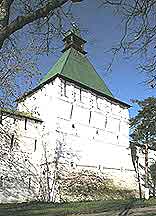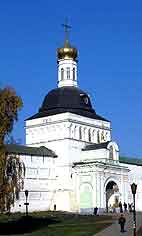 The Drying Tower stands to the north of the Assumption Cathedral in the eastern part of the Monastery. It is rectangular in plan, like all non-corner towers. It is divided into three tiers by the stone vaults. The high tent-shaped roof with a watching platform and a wind vane on top gives an idea of the ancient appearance of the Monastery towers. During the siege of the Polish invaders a moat was dug at the eastern wall. In the early 18th century, Peter I took measures to protect the Monastery in case of a Swedish attack of Moscow. He ordered to make ramparts opposite the Monastery Towers. In 1823 and in 1836, the moat was filled in with earth and the ramparts were destroyed.
The Drying Tower stands to the north of the Assumption Cathedral in the eastern part of the Monastery. It is rectangular in plan, like all non-corner towers. It is divided into three tiers by the stone vaults. The high tent-shaped roof with a watching platform and a wind vane on top gives an idea of the ancient appearance of the Monastery towers. During the siege of the Polish invaders a moat was dug at the eastern wall. In the early 18th century, Peter I took measures to protect the Monastery in case of a Swedish attack of Moscow. He ordered to make ramparts opposite the Monastery Towers. In 1823 and in 1836, the moat was filled in with earth and the ramparts were destroyed.
The Red Gateway Tower (17th c., reconstructed in 1856)
 The Red (beautiful) Tower was constructed over the main gate in the eastern wall. So it was coated with white stone emphasizing its importance, though the Tower was not large and its architecture was modest. The fortress builders evidently meant to transfer the main architectural significance of the entrance from the Tower to the Gate Church behind it.
The Red (beautiful) Tower was constructed over the main gate in the eastern wall. So it was coated with white stone emphasizing its importance, though the Tower was not large and its architecture was modest. The fortress builders evidently meant to transfer the main architectural significance of the entrance from the Tower to the Gate Church behind it.
The Red Tower was fundamentally reconstructed in the 19th century, and, as the result, it lost its defensive character. The brick superstructure of the 17th century clearly differs from the white-stone foundation, marking the border of the ancient tower. The Tower preserves the later portal (1807) and the top (1856). In 1958, the Red Tower was examined and the restoration plan was worked out.
|


